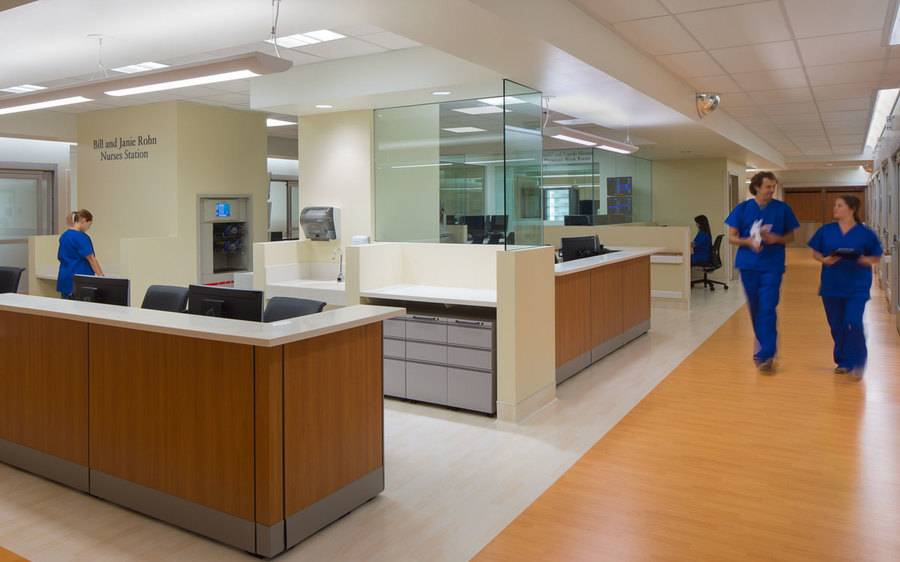Barbey Family Emergency and Trauma Center Opening On Scripps Memorial Hospital La Jolla Campus
$33 million facility significantly increases capacity for treating emergency, trauma patients

$33 million facility significantly increases capacity for treating emergency, trauma patients
Scripps Health cut the ribbon on the Barbey Family Emergency and Trauma Center on the Scripps Memorial Hospital La Jolla campus. The new $33 million facility includes 51 private beds, four ambulance bays and the latest technology for treating everything from cuts and falls to major life-threatening injuries.
The 33,000-square-foot center, which officially opens for business on Sept. 26, is six times larger than the space it replaces in the campus’ original hospital building. The new center is located on the first floor of the Prebys Cardiovascular Institute.
“Thanks to the generosity of the Barbey family, Scripps will be able to provide for the emergency needs of patients in the region for years to come,” said Scripps President and CEO Chris Van Gorder. “By expanding our emergency and trauma services, we are strengthening our mission to serve the health care needs of our community while offering the highest quality of care possible.”
Philanthropic funding for the center was led by a gift from the Barbey family. Other donations included a gift from the David Whitmire Hearst Jr. Foundation, which supported the naming of the trauma area inside the new center after Brent Eastman, MD, former Scripps chief medical officer and trauma surgeon.
As part of San Diego County’s trauma system, the Barbey Center is an important element of a nationally recognized model that has treated thousands of patients with serious injuries over the past three decades.
Technology highlights
The center is equipped with a mobile fluoroscan X-ray device that can be used to quickly create detailed images of bones and joints, giving doctors a baseline for follow-up examinations. Overhead imaging devices are available throughout the entire trauma area, allowing for x-rays to be taking on two patients simultaneously.
Additionally, a radiology department embedded in the center allows for speedy and convenient access to other state-of-the-art imaging technologies, which include a low-dose CT scanner with full cardiac and neurological scanning capabilities; a 1.5 tesla MRI; an ultrasound unit with diagnostic and vascular scanning capabilities; and two diagnostic x-ray imaging suites.
Another important piece of technology at the center is a transesophageal echocardiography device, which lets physicians view the heart’s valves and chambers from an ultrasound probe guided down a patient’s throat at the same time clinicians are performing potentially life-saving CPR. Without this device, CPR would have to be stopped while the patient is taken to an echocardiography lab for scanning.
Other highlights include:
- Four trauma bays that can expand to eight in a disaster
- Four psychiatric beds
- Four negative pressure rooms for infection isolation
- Four ambulance bays
“We have a highly trained and very experienced emergency and trauma staff which cares for about 40,000 patients a year, or 110 patients each day,” said Martin Griglak, MD, medical director and chairman of the Department of Emergency Medicine. “With volumes expected to increase over the coming years, our expanded capacity ensures that Scripps will be able to meet the growing demands for emergency and trauma services.”
Patient comfort at center of design
Each room and bay contains a continuous vital signs monitor; a bedside clinical staff computer; a rolling bed that can measure the weight of a patient for medication dosage and other needs; and a storage cart filled with extra pillows, blankets and other supplies.
All of the rooms also include flat-screen televisions and seating for family members and other visitors. The screens can be used to display patient images, such as x-rays, and other medical information during discussions with clinicians.
The 16-bed David Whitmire Hearst, Jr. Foundation Observation Area offers more secluded rooms designed for patients who are waiting to undergo more extensive testing, particularly elderly patients who might be more comfortable in a quieter atmosphere. Each room is enhanced by natural light from large windows.
A waiting room bathed in natural light from large windows provides comfortable seating and tables equipped with power jacks for charging mobile phones, tablets and laptop computers. The center also features a subdued color palette to help increase patients’ sense of well-being and to boost the healing process. Art work depicting San Diego’s natural beauty is placed throughout the center and in every patient room, thanks to the generosity of donors who have supported the project.
“The design of this new facility places an emphasis on patient comfort and staff efficiency,” said Imad Dandan, MD, trauma medical director. “We are fortunate to have a state-of-the-art facility providing the highest level of care to those with the most urgent medical needs.”
Patients and visitors can park in a surface parking area located directly in front of the center’s main entrance, which features a covered, weather-protected driveway for drop offs.
Planning and construction of the center was completed in just over a year on time and on budget. The designer was HOK and the design-build general contractor was McCarthy Building Companies, Inc.
A team of Scripps emergency and trauma physicians, nurses and technicians worked directly with architects in designing the center, and that effort included visits to three other emergency/trauma centers in California.
“The opening of the Barbey Center is a significant milestone for our patients and staff,” said Gary G. Fybel, chief executive of Scripps La Jolla. “Our efforts in recent years to reshape the Scripps La Jolla campus has ensured our ability to continue delivering the best medical care to our community for generations to come.”
Learn more about Scripps Health, a nonprofit integrated health system in San Diego, Calif.
Media Contact
- Keith Darce
- 858-678-7121
- darce.keith@scrippshealth.org